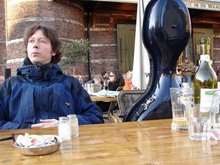
This is exactly what fascinates me as a musician. What were the demands at the time when this bow was made? Who played it, and what kind of music did he or she (most likely he) play? In which tradition does it fit?
My newly acquired bow has a “Cramer head”; this means that the tip of the bow is pointed in two directions. It is named after Wilhelm Cramer (1745-99), a German violin virtuoso who used a bow of this type. It is not entirely clear when and how the Cramer bow has developed. Cramer started his career in Mannheim, but I don’t know if the Mannheimers were using this type of bow already at that time. David Boyden has suggested that Cramer obtained his first “Cramer bow” in Paris, where he regularly performed. It is true that French bow makers like Duchaine produced Cramer-type bows as early as 1750. In 1773, J.C. Bach invited Cramer to London, where he was the leading violinist until the arrival of Viotti in 1992. However, English bow makers were already making “Cramer bows” before Cramer’s arrival in 1772. My bow may be an example of those early English Cramer bows, and since it was not made by a famous maker it suggests that they might have been widely spread already.
Traditionally, the Cramer bow (axe head) is placed chronologically between the “Tartini” bow (pike head) and the Tourte bow (swan head), which is basically a modern bow. But bows with a Tourte-like head were already being made at the same time Duchaine made his Cramer head. In fact, the three types have been in use simultaneously for a couple of decades. All we know for sure is that the pike-head came first and that eventually the Tourte model won, but not before Paganini (and his Cramer bow!) had left the stage around 1830. I don’t see how the Cramer head should have “evolved” to the swan head; in my opinion it is more a Neanderthaler than a missing link.
By far the most surviving Cramer bows come from England. I think there is no doubt that this has to do with Cramer’s dominant position as an orchestra leader in London for two decades. This must have created quite a strong demand for Cramer bows. Many beautiful examples have been made by members of the Dodd family.
So, if we want to be “historically informed” players, which repertoire can we play with our Cramer bows nowadays? I would say that this is a matter of personal preference, just like it was in the late 18th century. It’s an interesting question if the Cramer bow in some form was already in use in Mannheim when Cramer was still the leader of the orchestra. For the music played in London in the 2nd half of the 18th century, including that of J.C. Bach, Abel and Joseph Haydn, the Cramer bow seems to be a smart choice. Viotti used both types; Paganini always used a Cramer bow. What about 2nd half 18th century French music? And did the Cramer bow make it to Vienna?
I am deeply in love with my new bow. At the moment, it is the best 18th century type bow in my collection and I am going to use it a lot, also for music which has no clear connection to Cramer, like Mozart and maybe even some early Beethoven. The sound is beautiful and the articulation is exceptionally clear. Playing a simple Haydn cello part with this bow is pure joy.
My biggest surprise was when I was trying out a sonata by Pieter Hellendaal, which was published in London around 1780, but written in an old fashioned, Tartini-like style. In the 2nd movement there is a passage with broken chords, in which the bow is supposed to jump lightly from the string. I have never been able to play this passage convincingly. With my new Cramer bow, it works beautifully, and without any effort!


No comments:
Post a Comment